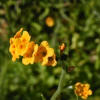
Coarsegold, California
Revised
1-4-09
![]()
.jpg) NOTES
NOTES
Elegant Clarkia
|
.jpg)
Elegant Clarkia, Double
|
.jpg)
Elegant Clarkia, Double
|
.jpg) NOTES
NOTES
California Dodder
|
 NOTES
NOTES
Menzies'
Fiddleneck
|
.jpg) NOTES
NOTES
Globemallow
|
 NOTES
NOTES
Whiteleaf Manzanita,
Berries |
|
.jpg) NOTES
NOTES
Scarlet Pimpernel
|
.jpg)
Scarlet Pimpernel
|
.jpg) NOTES
NOTES
Indian Pink
|
.jpg)
Indian Pink
|
.jpg) NOTES
NOTES
California Poppy
|
.jpg)
California Poppy
|
.jpg) NOTES
NOTES
Squawbush, Berries
|

Squawbush, Leaves |